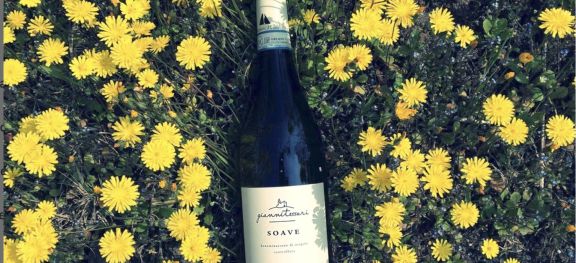Giannitessari 2021 Soave

A repeatedly impressive food wine exemplifies Soave at its best.
From €8.50, 2,074 Japanese yen, $15.49, £14.50, AU$26.95
For wine professionals, most encounters with wine are necessarily fleeting. I first tasted Giannitessari Soave in November last year at Borsa Vini, an Italian trade fair in Singapore. Tasting the wine itself took less than a minute, but it subsequently became the wine I've drunk most often, thanks to an uncanny – and unexpected – compatibility with Singapore's many and varied local cuisines.
If you prefer the one-minute version, here it is: this is Soave as you always wanted it to be. Pear fruit is the main flavour, but I've variously found citrus, apple and spice, while Tamlyn noted plenty of floral character. It's appropriately moderate in acid, with creamy texture contributing to body and persistence. Don't expect revelatory complexity here: the joy of this wine is its stylish primary fruit, pillowy softness and pleasing typicality. At its price, this is a best-in-class bottle. Satisfaction in a glass!
Now for the detail. This wine's ability to match a range of Asian flavours was discovered while researching how to pair wine with food commonly found in Singapore. Alongside 30 dishes that ranged from char siew (sweetly spiced pork) to otah (potently piquant fish cake), I selected 10 wines covering every major style. There was sparkling both young and old, three weight divisions of red (Pinot Noir, Rioja Reserva and Shiraz), one rosé (from Provence), and four whites covering various levels of sweetness and oak influence.
To fill the 'non-aromatic, unoaked white' slot, I picked the Giannitessari, both because it fitted the remit perfectly and because it comes from a region steeped in food and wine. Indeed, Tam describes it as 'the perfect risi e bisi wine', but it goes far beyond rice and peas. Over the course of several weeks, I tasted it multiple times with multiple people and multiple dishes, and it was comfortably the most reliable match every time.
The reasons for this compatibility are intriguing, and not necessarily in line with received wisdom. With a flavourful chicken red curry, the Soave was a much better match than a good Vouvray Demi-Sec, whose sweetness clashed with the coconut milk. It was also better with monkey-head rendang (not a literal monkey head, but a type of mushroom) than a Spätlese Riesling, again because a dry finish was much more appetising and fresh.
So much for the old canard that sweeter whites match better with spicy foods.
In fact the Soave was the most consistently good match among the whites (among the reds, it was the Rioja). That doesn't mean it always elevated the pairing, but it nearly always complemented, and very rarely clashed. This is most likely thanks to its seemingly mild-mannered nature – no oak, no sweetness, no searing acid – with ripe pear fruit providing the ideal backdrop for spice levels from aromatic to piquant and ingredients from citric to umami.
The Tessari family can trace its Veneto heritage back to the year 1616, and has been making Soave to great acclaim since the 1980s. Gianni struck out on his own in 2013, assisted by his two daughters Valeria and Alice (it was Valeria who was pouring their wines at Borsa Vini). The blend of their 2021 Soave is 85% Garganega with 15% of Trebbiano di Soave, and the winemaking is otherwise very straightforward: temperature controlled in stainless steel.
What started as a brief encounter has turned into a full-on love affair. The vintage I've fallen for is 2021, which is still widely available – from Jeroboams in the UK and via WP Wine Imports in Napa, CA (info@wpwineimports.com) as well as the retailers listed by Wine-Searcher – although I see that the 2022 is now in distribution. I hope it will prove equally versatile, and I will be lining up the dishes to find out.
Members have access to more than 236,000 tasting notes on our database, including more than 300 from the Soave DOC.
Become a member to view this article and thousands more!
- 15,435 featured articles
- 274,222 wine reviews
- Maps from The World Atlas of Wine, 8th edition (RRP £50)
- The Oxford Companion to Wine, 5th edition (RRP £50)
- Members’ forum
- 15,435 featured articles
- 274,222 wine reviews
- Maps from The World Atlas of Wine, 8th edition (RRP £50)
- The Oxford Companion to Wine, 5th edition (RRP £50)
- Members’ forum
- Commercial use of our Tasting Notes

